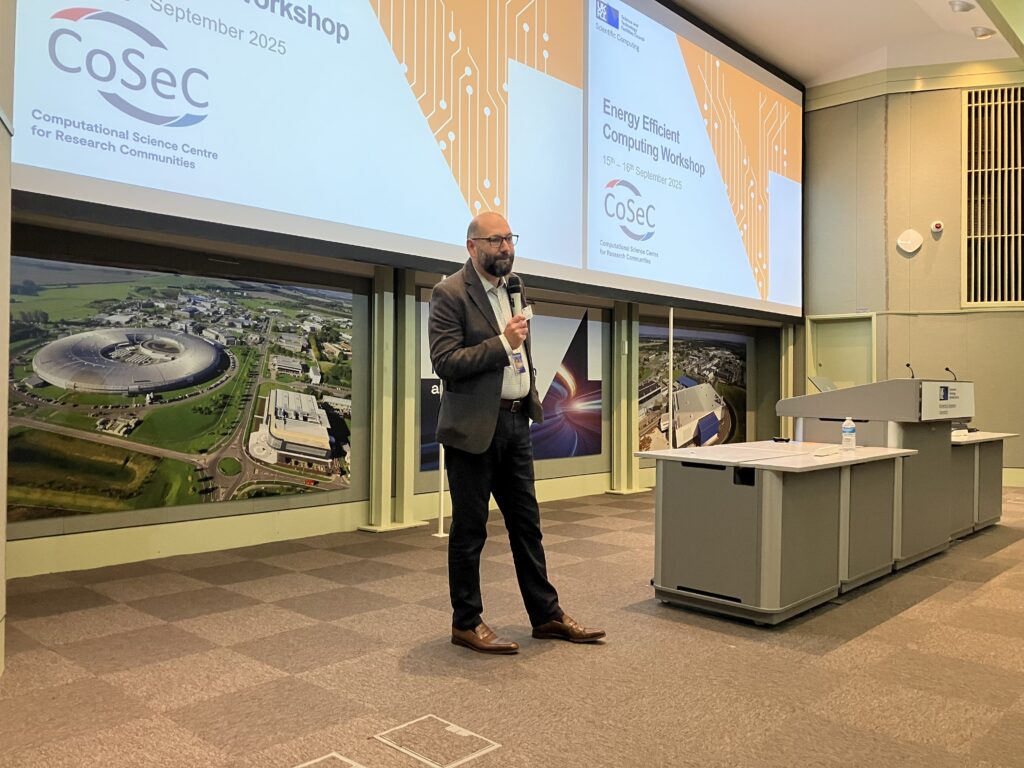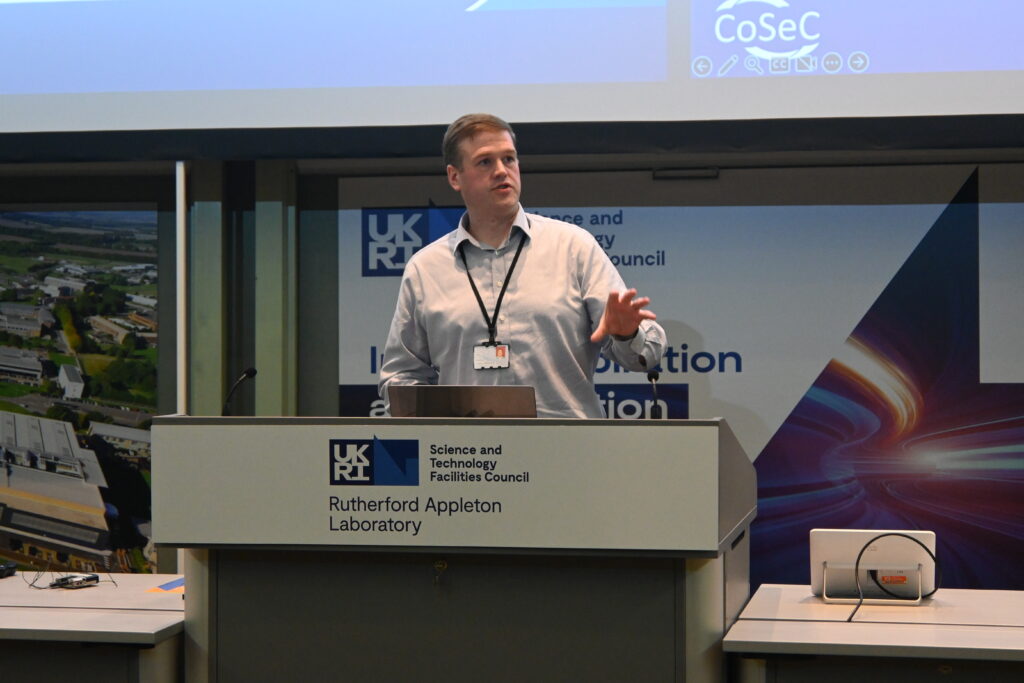On 15th-16th September 2025, an Energy Efficient Computing workshop was held at Harwell Campus, organized by STFC Theme Lead for Mathematics Tyrone Rees, Software Engineers Jessica Huntley and Adam Greenbank, and CCP-DCM Project Lead Hussam Al Daas.
The workshop was primarily aimed at software development teams embedded within our communities at CoSeC. The sessions revolved around four key themes: Qualitative Algorithms, Community, Hardware, and Quantitative Practice and was designed to share knowledge and start conversations around making energy-efficient choices.


Tyrone Rees (left), STFC Theme Lead for Mathematics opened the workshop and our Director, Dr Stephen Longshaw (right) talked about CoSeC, current developments and plans for the future and a summary of each talk is available below.
Co-Organiser Jessica Huntley said:
It was great to see high levels of engagement across different communities and user groups during the workshop, which sparked interesting conversations and highlighted the importance of taking a multi-disciplinary approach to embedding energy-efficient computing practices. The high-quality talks also stimulated some great discussions as part of our breakout sessions, giving us lots of ideas to take forward in the next phase of our project.
Laura Grigori (EPFL, PSI)
Randomized Methods for Efficient Scientific Computing
Professor Grigori explained that the aim of her research is about bringing maths to research in the race for faster, more complex supercomputers. There is a challenge in obtaining scalable and robust Numerical Linear Algebra methods and venues to explore include communication-avoiding algorithms and randomization techniques.
Her conclusions recommended a focus on designing randomized methods that can achieve far better performance on emerging architecture compared to standard deterministic ones while preserving the required numerical accuracy.
Grey Ballard (Wake Forest University)
Efficient Dense Tensor Computations
Standard data analysis methods are based on matrix techniques. However, many datasets are multidimensional by nature. Flattening/matricization of these datasets in order to analyse them destroys the underlying structure. Professor Ballard recommended using extensions of matrix data analysis tools such as Principal Component Analysis to multiway data structures (aka tensors) to achieve faster data analysis, larger compression ratios and structure preserving representations.
Théo Mary (LIP6, Sorbonne University)
Green Computing via Mixed Precision
The increasing support of lower precision arithmetic in hardware provides new opportunities for high performance scientific computing, and in particular green computing. Indeed, low precision arithmetic provide significant speed, communication, but also energy benefits.
However, their use in scientific computing poses the challenge of preserving the accuracy and stability of the computation. To address this issue, a variety of mixed precision algorithms that combine low and high precisions have emerged. Dr Mary gave an overview of mixed precision algorithms in numerical linear algebra with a focus on energy efficiency. To find out more about Theo and his research, please visit his website.
Hatem Ltaief (KAUST)
Sustainably Modeling a Sustainable Future Climate
Dr Ltaief asserted that it is vital to understand the hardware technology landscape and examine the performance evolution of GPUs. He recommended achieving sustainable computing with the use of the software HiCMA, which compresses and operates only on the most pertinent data, while supporting adaptive mixed-precision computations on heterogeneous architectures. When powered by the dynamic runtime system PaRSEC, HiCMA can also reduce the volume of data communications by using an automated precision conversion strategy, which results in a further increase in energy efficiency.
Garth N Wells (Cambridge University)
UKRI Living Benchmarks
Funding mechanisms in the UK can make good benchmarking for procurement hard and it is important to develop procurements that will influence future Digital Research Infrastructure (DRI) investments.
Procurements are dominated by commercial terms. The market is currently not competitive enough as one would hope and both price and performance are major competition points.
Therefore, Professor Wells and his team have been working on developing a benchmark suite to facilitate a new, sustainable approach to UKRI benchmarking. This suite will be wholly open-source, with a range of application domains and a deep understanding of performance characteristics. For future procurements, one can then draw from a set of public, well-developed benchmarks and vendors can have an early sight of these to prepare.
Kirsty Pringle (SSI, EPCC, University of Edinburgh)
Building a Green Computing Community
Dr Pringle felt that there is currently a lack of clear direction in the green computing community, and because the research landscape is so diverse a range of approaches is required rather than a single answer. Change requires not just new technologies, but new ways of working, collaborating, and sharing responsibility.
Therefore, a community-based approach is key and has more potential as to how to make change happen. A community-based approach has its challenges but can be a valuable tool for creating change and achieving solutions. A Green RSE Special Interest Group has been set up to drive ideas forward and explore the role of research software engineers in the transition to Net Zero Digital Research infrastructure.
Loïc Lannelongue (Green DiSC, University of Cambridge)
Green DiSC, ESCS Forum, Green Algorithms… making computational science more environmentally sustainable one tool at a time
Dr Lannelongue introduced the Green Algorithms project, which is about empowering computational scientists, organisations and funders to understand and mitigate the environmental impacts of their work. It regroups calculators that researchers can use to estimate the carbon footprint of their projects, tips on how to be more environmentally friendly, training material, past talks etc. Google had tried estimating their carbon footprint, with their writers saying that AI has no carbon footprint. However, these arguments were not rational and eventually emerged in the BBC news, revealing Google’s gas emissions increased by 48% in 5 years due to AI! AI means Google’s greenhouse gas emissions up 48% in 5 years – BBC News
The team are now working on the Green Algorithms Dashboard, which will be open source and easy to deploy, implementing computing facilities that can offer a perspective of energy and carbon use at user/group/department level. The vision for Green DiSC is to build a new certification scheme which provides a roadmap for research groups and institutions who want to tackle the environmental impacts of their computing activities.
Martin Juckes (CEDA)
Translating efficiency into environmental sustainability
Dr Martin Juckes explained that physical infrastructures supported by the digital research infrastructure (DRI) currently have significantly larger carbon footprints than the DRI itself, but that the DRI footprint could expand rapidly. Looking beyond the research sector, we see plans for a 1GW capacity site in the US Stargate programme and plans for 500MW data centres in the UK AI Growth Zone. We are seeing huge efficiency gains in computing, both in research and beyond, but those gains in efficiency are driving greater demand and leading to enhanced, rather than reduced, resource use.
In order to translate efficiency into environmental sustainability, there needs to be a shared responsibility and a cultural shift, with action to be taken in three main areas: within the UKRI Research councils, by jointly delivered work and independent academic activity. NetDRIVE is part of this jointly delivered work and will create a trusted source of information through a Network for Transformational Change.
Andy Turner (EPCC, University of Edinburgh)
Carbon emissions from HPC systems: quantification and reduction
Dr Andy Turner first focussed on why individual action matters. Taking no real action is not a reasonable response – as individuals, we can have a real impact to make change, such as exerting pressure on workplaces and councils and leading by example. He outlined emissions which are dominated by compute cabinets and that the only way to improve HPC-CI metric is through carbon abatement activities or improved efficiency. Carbon abatement strategies include reducing usage, demand shifting/shaping e.g. temporal shifting to run calculations at a time when emissions are lower and improving performance.
Assessing emissions profiles of large DRI is required to make useful decisions about reducing emissions and the balance between embodied and operational emissions had a large impact on how you improve emissions efficiency.
For future work, Andy recommended examining the impact of hardware failure on emissions for ARCHER2, looking at the scale of wasted emissions from failed or redundant jobs, and rolling out the use of HPE PowerSched to allow for dynamic system power capping and test application performance.
Zeyu Yang and Wes Armour (University of Oxford)
Energy Efficient Computing for GPUs
Professor Wes Armour explained that whilst GPU is the go-to accelerator for HPC workloads, its power consumption is rapidly becoming a major concern. An understanding of this power consumption is therefore vital to improve its energy efficiency and reduce its carbon footprint.
For a bandwidth-bound algorithm, it makes no sense to have GPU cores running as quickly as they can. The reason is that your memory cannot deliver data to them quickly enough to utilise all of the computation that they can perform. Therefore, the processing core frequency needs to be turned down.
Accurate measurement of power consumption is essential for improving the energy efficiency of algorithms. Researchers often rely on nvidia-smi to measure the power usage of NVIDIA GPUs, but this common practice can be misleading. Zeyu Yang introduced their research examining the accuracy of NVIDIA GPU’s built-in power sensor, which is widely used by researchers to enhance the energy efficiency of applications.
During their research, their team examined over 70 different GPUs across 12 architectural generations, identifying various issues that can lead to drastic under/overestimation of energy consumed. In some cases, only a small fraction of the runtime is actually measured. They proposed mitigation strategies to reduce these errors, along with a measurement standard and accompanying resources, all available on GitHub. Building on these insights, they also analyzed the energy–accuracy trade-offs of over 1,200 ImageNet vision models, highlighting opportunities for more sustainable AI and high-performance computing.